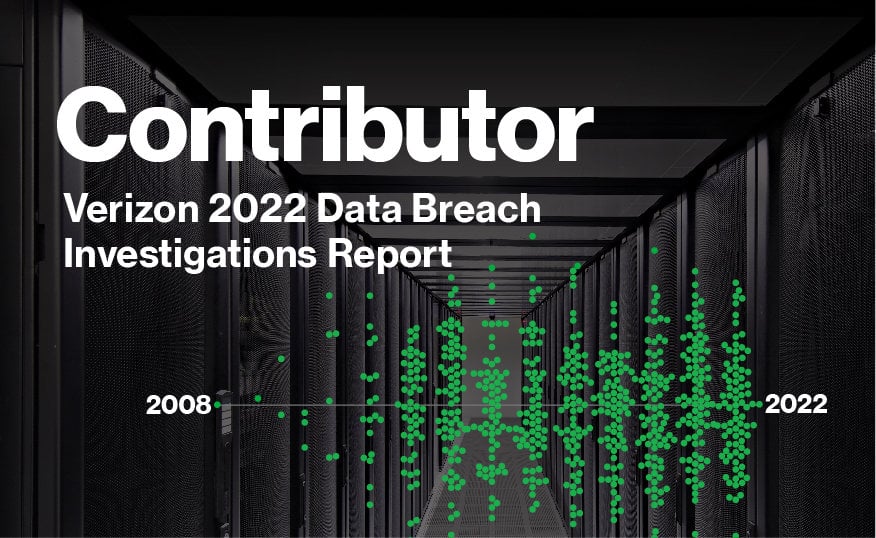Top Takeaways from the 2022 Verizon Data Breach Report & How to Reduce Your Risks

One note before we begin. Keep in mind that any industry report is limited in that they can only analyze and provide insight into the data available to them. Currently, there is no centralized way to track data breaches across industries, countries, states, etc. So, the data in the 2022 Verizon data breach report is limited to what was reported to Verizon. That said, they analyzed 23,896 security incidents, so they are drawing from a good-sized pool. Keep in mind that the data analyzed is from 2021.
Some Background on the Verizon Data Breach Report

Key Takeaways From the 2022 Verizon Data Breach Report
No surprise to our team, ransomware is on the rise, growing by 13% over the past 5 years, and it contributed to 25% of incidents in 2021. The most common errors reported were related to cloud misconfiguration and contributed to 13% of the attacks. Regardless of incident type, 82% of incidents involved the human element.
How Are the Criminals Compromising Networks?
The 2022 Verizon data breach report breaks access down into four methods by threat actors. In order of likelihood:
- Credentials
- Phishing
- Exploiting Vulnerabilities
- Botnets
These are the areas that should be prioritized when securing your infrastructure, so let’s look at each briefly.
Credentials
Whether credentials are harvested, stolen, purchased on the dark web, or guessed, according to the 2022 Verizon data breach report, cybercriminals used credentials to access nearly 50% of the organizations that were breached in 2021. If you’re a regular reader of our blog, you may already know what I’m going to say next, but these tactics are crucial and bear repeating.
Here are strategies you should use to protect your organization against attackers who gain access by using valid credentials:
- Require strong passwords of 16 characters or more, encouraging users to think in terms of passphrases such as song lyrics, movie quotes, or even four random words. Complexity (such as adding special characters) is not as important as length. Plus, spaces and punctuation are special characters. We have a blog on the data behind password lengths that is worth a read.
- Don’t reuse passwords across different services or accounts. If a service such as LinkedIn has a data breach, the passwords will be readily available for purchase or free download on the dark web. Criminals will try those compromised credentials against other sites.
- Don’t use shared passwords for any accounts but especially for privileged accounts like local administrator or service accounts. If a criminal gains access to the password, they not only have elevated privileges, but access to any system using that shared password.
- Implement multi-factor authentication (MFA) through an authentication app. Even if a criminal gains access to valid credentials, those credentials are not enough to gain access so long as MFA is in use. Read our MFA overview and best practices tip sheet for more information.
- Provide access to a password manager like Dashlane or LastPass and train your users to use it. Our brains weren’t designed to remember 200-300 unique passwords, so let an app do the heavy lifting.
Phishing
According to the 2022 Verizon data breach report, criminals continued to send emails in an attempt to trick users into clicking links, opening attachments, or providing information (like credentials), contributing to about 20% of compromises in 2021.
Help your users out by:
- Employing robust spam filtering
- Blocking unnecessary attachments
- Stripping known malware from email messages
- Providing regular training to teach users to recognize phishing
- Tell users what to do if they make a mistake and fall for a phishing email
While the first three items will provide levels of protection, we all know that no filtering or blocking is 100% accurate and bad stuff still gets through, so training is still necessary and important. Even more critical is letting users know what to do if they make a mistake. We are all human, and we all make mistakes. In the case of phishing, self-reporting those mistakes as soon as they happen allows the organization to implement extra measures (such as password resets or system isolation) to limit the damage. For more information on phishing, read our phishing blog series and download our tip sheets on phishing prevention and how to spot a phishing email.
Exploiting Vulnerabilities
In 2021, we saw that one zero-day vulnerability in key software or the supply chain can lead to a large-scale compromise with hundreds or thousands of victims. While only contributing to about 10% of compromises, we anticipate that number will continue to grow—in fact, it earned a spot on our list of the 4 Top Cybersecurity Threats for 2022.
To protect against vulnerability exploits, organizations should:
- Create an inventory to document the software and systems in use and ensure you can access it quickly in the event of a zero-day vulnerability.
- Maintain a robust patch management program. Patches should be applied in an automated fashion, and as soon as feasibly possible. As soon as a zero-day becomes known, cybercriminals begin scanning for exploitable systems. Patch fast. Watch our 3-minute video on patch management tips.
- Talk to your vendors about providing a Software Bill of Materials (SBOM) so that you know what underlying tools, software, or components are a part of their solution. You can’t patch what you don’t know is present. Read our blog on why and how to incorporate SBOMs into your cybersecurity strategy for tips on how to move forward.
Botnets
As many of you probably know, botnets are large groups of computers that are being controlled by a cybercriminal group. In most cases, the computer’s user is not aware that it is part of a botnet. The activity is taking place in the background and may not impact the system at all. Botnets are primarily used for Denial of Service (DoS) attacks. While the 2022 Verizon data breach report found that these were used in less than 5% of attacks in 2021, a DoS attack can result in a system or network becoming unusable and lead to a lot of unhappy customers! The best way to prevent or prepare for DoS attacks is by using a service like CloudFlare, and/or maintaining redundant Internet connections (through separate providers and separate relays) if possible.
In Closing
Cybersecurity incidents will continue to happen. However, by educating ourselves about the most common attacks and understanding how to protect our organizations, we can successfully reduce the likelihood and the impact of an attack if it does happen. At LMG Security we are passionate about helping our clients build robust security programs to address all areas of risk. Contact us if you need help with technical testing, cybersecurity solutions, advisory services, training, or incident response. We’d love to work with you.

